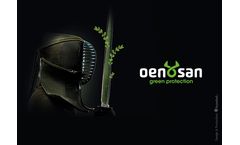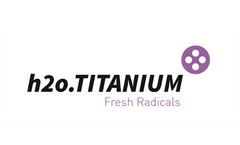Refine by
Plant Leaf Articles & Analysis
19 news found
Only 2 years after its foundation, Basquevolt now has a prototype manufacturing plant for its own cells, which also includes a production area for its patented electrolyte (gel polymer), a key element in the innovation of this new generation of batteries. The plant, whose construction began in the summer of last year, is already operational and has state-of-the-art machinery for the ...
Borage plant frost protected by Oenosan Borage or Borago officinalis is an annual flowering plant. Borage is a herb native to the mediterranean region but nowadays it is found all over Europe from Denmark to the south of France. Its a self seeding plant and the leaves are edible. The plant has many useful characteristics and therefore it’s commercial ...
ByOenosan
Richard Glass, Sector Lead at CHAP said: “Plant protection products remain an important input for growers, ensuring they can reliably produce crops to feed the world’s rapidly expanding population. ...
Following a successful Smart Grant application, a three year feasibility study called SprayBot will take place delivered by Crop Health and Protection (CHAP) in collaboration with partners Newcastle University, Small Robot Company and Fotenix.SprayBot will investigate how combining early disease detection techniques such as imaging and spore sensors with robotic machinery can create a system to ...
Light is one of the most important factors for optimizing plant growth. Plants collect energy from light to make sugars and these sugars are used for the growth of roots, leaves, stems and flowers. ...
Scientists from Wageningen University & Research demonstrate that the productivity of a next main crop can be manipulated through the choice of species in a preceding winter cover crop mixture. They report their latest findings in the Journal of Applied Ecology of 2nd of June. With their publication, the scientist agree with recommendations of FAO to included cover crops in rotations, on ...
Growers whose corn crops were harmed by excessive rain in April and May likely will have enough growing days left in the season if they replant in the next two to three weeks, according to an Ohio State University agronomist. “If they replanted soon, it would probably be much better than to have a poor stand,” said Peter Thomison, an agronomist with Ohio State University Extension, ...
In addition, the efficacy of chlorine as a disinfectant in washing is determined by the location of the pathogen in the plant leaf: The internalization of microorganisms in plant tissues, the inaccessibility of chlorine to bacteria in holes or fissures of plant tissue, and the presence of biofilms and waxes in vegetable tissues ...
A time-lapse polarized imaging system may help citrus growers detect greening before the plant’s leaves show symptoms, which should help growers as they try to fend off the deadly disease, a new University of Florida Institute of Food and Agricultural Sciences study shows. For the new study, Won Suk “Daniel” Lee and Alireza Pourreza wanted to know how early citrus leaves with ...
The greening disease bacterium first enters a citrus tree via the tiny Asian Citrus Psyllid. When introduced into the plant by leaf feeding, the bacteria then move through the tree via the veins of the tree. ...
” Research on the utilization of these genes was conducted initially to develop a more consumer-friendly, alternative, plant-derived, system. They are the first step toward Florida farmers producing blood oranges and, possibly, a new grapefruit cultivar. In addition to changing the color of the fruit, the introduction of anthocyanins also change the color of leaves stems ...
Weeks of record rainfalls drenched Don Lamb's cornfields this summer, drowning some plants and leaving others yellowed, 2 feet tall and capable of producing little, if any, grain. The 48-year-old central Indiana farmer can't recall anything like the deluges he's seen from late May on this summer; the latest was a 4-inch downpour a week ago. Neither can his father, who's been farming for 50 ...
The authors of a new study say that understanding container-grown plants' capacity to "capture" sprinkler irrigation water can give growers important tools that help them adjust irrigation rates, reduce water use, and produce healthy plants. ...
LED lights are positioned just above the plants illuminate mainly the leaves (leaf lighting) or LEDs illuminate mainly the fruits (fruit lighting). ...
Livestock producers looking for a relatively easy and inexpensive feed source can turn to harvested cornfields for the answer. The residue left on the field after harvesting corn can be used to meet the nutrient needs of ruminant livestock in early to mid-gestation, according to a forage expert from Ohio State University’s College of Food, Agricultural, and Environmental Sciences. As the ...
“These populations were confirmed to have moderate levels of resistance, exhibiting high rates of survival (63 and 86 per cent) following label rate glyphosate application on two-leaf plants,” he said. “The third population was identified following an AHRI survey in 2010 and 2011 of 239 paddocks in WA’s northern and central ...
Certain vegetables take up heavy metals from contaminated water used for irrigation, a new study finds. The researchers grew vegetables in greenhouses similar to field conditions in Greece and found that concentrations of nickel and chromium increased in potatoes and onions, but not in carrots, when irrigated with water containing contaminant levels similar to those found in industrial ...
Pest-resistant genetically modified (GM) maize makes up an increasing proportion of maize grown commercially in the EU. A new study shows that earthworms may help break down the toxins produced by GM maize. GM maize (Bt-maize) plants are engineered to produce 'cry' proteins that are toxic to the European corn borer, a major insect pest responsible for corn crop losses. Recent studies have shown ...
COLLEGE STATION, Texas, October 9, 2007 (ENS) - American cars and trucks may soon be fueled with sorghum. Not used widely as a food grain in the United States, sorghum is one of the five top cereal crops in the world, along with wheat, oats, corn, and barley. It was cultivated in Egypt in ancient times, and Africa still is the largest producer of sorghum today. Now, energy crop company Ceres, ...












